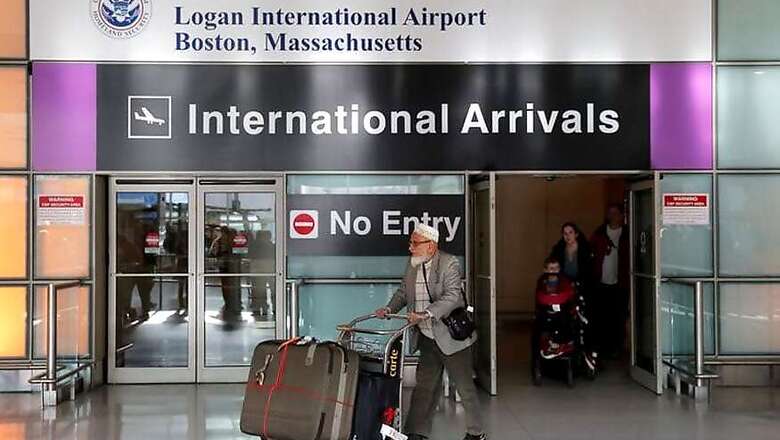
views
New Delhi: Gone are the times when India was concerned about young and skilled workforce migrating to apparent greener fields in search of better work opportunities, education and other development-based advantages the West has over India. The Narendra Modi government is mulling on a policy to facilitate skilled workforce to find employment abroad, a full cycle from its earlier apprehensions on ‘brain-drain’.
The policy plans to make it easier for masons, carpenters and plumbers, among other skilled persons, to get jobs overseas by laying a roadmap that will track the requirement of such professionals abroad as well as the certifications required in different countries.
As of now, the skill development and entrepreneurship ministry is planning to present the policy to the Union cabinet for its approval.
“One has to understand the importance of the move that the government is taking up. The entire concept of retaining workforce so that the country has enough stock is being negated. It is a very forward looking approach. What this does is it comes back to the country as remittances. More than just monetary benefits, it reflects India opening up to opportunities beyond borders,” said Kris Lakshmikanth, chief executive officer and managing director, Head Hunters India, a job portal.
In a report published last year by tax and advisory firm, Grant Thornton, used by the government of Madhya Pradesh for analysis, remittances have seen a late decline after a constant upscale for the last 10 years. However, demand for Indian workforce overseas has been on the rise. World Bank data recognizes the fall in remittances as well, despite which India has the highest remittance return in the world.
Remittance, here, is a sum of money sent back to the home-country from employees working abroad.
Last year, the government announced launch of 50 India International Skill Centres in partnership between skill development and entrepreneurship ministry and ministry of external affairs to train youth under the Pravasi Kaushal Vikas Yojana.
However, the lack of adequate information from across the globe on the kind of skills required and the basic minimum certification needed for placements kept Indians away from bagging jobs abroad.
“Rising demand for Indian workers abroad can be ascertained by the number of vacancy and admitted ratio we have seen in the recent past. By this we mean, that multi-national companies that come up with vacancies for various posts open for foreign nationals have a lot of Indians bagging the job. According to us one of the more important reasons behind Indians doing well abroad is the work-culture in the country. Somehow, Indians tend to work more,” said a spokesperson of Naukri.com, a job portal.
The move comes in line with the Prime Minister’s vision to impart skills to 50 crore youth by 2022.
The motive behind the formulation of the policy is to increase the employability and acceptability of Indian youth on global platforms while ensuring they get the respect and remuneration they deserve.
According to the report cited above, on an average, skilled and unskilled workers migrate to different countries when looking for a job. People with technical skills and professional expertise migrate to countries such as the USA, Canada, UK, EU and Australia as permanent migrants. These workers usually take up healthcare, management, financial services or information technology jobs.
Semi-skilled workers on the other hand migrate mostly to oil exporting countries of the Middle East on temporary contracts.
Migrants at the lower end of the market comprise mostly unskilled casual labourers or those who own or hire small means of livelihood such as carts or rickshaws and are self-employed who look to move to the Middle East majorly Saudi Arabia and UAE in search of construction and retail trade jobs as these economies offer more jobs due to shortage of labour in the region. “They are economically sound countries offering better standard of living and income to unskilled labourers as compared to India,” added the spokesperson of Naukri.com.
The leading Indian states for outward labour migration included Uttar Pradesh, Bihar, Tamil Nadu, Kerala, Andhra Pradesh, West Bengal, Punjab, and Rajasthan. Together, these states accounted for over 80% of the migration from India at 678,644 outward migrants. Uttar Pradesh was the top contributor at 230,000 outward migrants.
While the government is working towards the facilitation, there are hurdles for Indian job-seekers especially when it comes to Europe and the United States of America.
The most sought-after H-1B and L1 visa, needed for working in the US specifically used by the large group of Indian IT employees has tighter norms now than ever before, in line with the American President Donald Trump’s goal to protect domestic workers from discrimination and replacement by foreign labour.
Similar decisions have been taken in the United Kingdom and Singapore.
Analysts however feel despite the visa issue Indian workers are in demand overseas and with the government pushing the same, the demand will only go up.
Spokesperson of Sony Corporation, a Japan-based multinational company said, “there are a lot more Indian nationals in our overseas branches than most other countries. The demand depends on the skill-set but we do have a lot of Indians applying.”
The migration trend has experienced a relative shift from prosperous states such as Kerala and Karnataka to poorer states like Uttar Pradesh and Bihar due to the excessive and sudden population growth in these states, leading to a high demand for jobs. Moreover, wage rates, particularly for low-skilled workers, in states like Kerala are fairly high compared with the rates in Bihar and Uttar Pradesh. This situation encourages low-skilled and less educated workers in poorer states to migrate abroad in hopes of earning greater income.
The key drivers for outward migration include low wages in India, growing working-age population and low employment generation rate.
Multiple reports point at the average yearly minimum wage in Europe, Saudi Arabia, Oman, and Australia at over $1,600, which is over 850% of the Indian monthly minimum wage ($175). However, a major challenge for the Indian economy is the generation of adequate employment for the fast growing working-age population.
Spokesperson of Tata Group said, “We not only take our Indian employees abroad but have stationed a significant lot in our overseas offices mostly in the United Kingdom. There is not only demand there is need for Indian everywhere.”
Addressing the fact that India will have surplus manpower of four-five crore over the next decade, Modi had emphasised at the launch of the Skill India Mission in 2015 on the need to provide this youthful manpower with skills and ability to tackle global challenges, and had warned that the demographic dividend would otherwise become a challenge in itself.




















Comments
0 comment